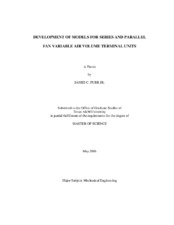Development of Models for Series and Parallel Fan Variable Air Volume Terminal Units
Abstract
Empirical models of airflow output and power consumption were developed for
series and parallel fan powered variable air volume terminal units at typical design
pressure conditions. A testing procedure and experimental setup were developed to test
sets of terminal units from three different manufacturers. Each set consisted of two
series and two parallel units, each with 8 in. (203 mm) and 12 in. (304 mm) primary air
inlets, for a total of four units in each set. Generalized models were developed for the
series and parallel units, with coefficients varying by size and manufacturer. Statistical
modeling utilized SAS software (2002).
Fan power and airflow data were collected at downstream static pressures over a
range from 0.1 to 0.5 in. w.g. (25 to 125 Pa) for the parallel terminal units. Downstream
static pressure was held constant at 0.25 in. w.g. (62 Pa) for the series units. Upstream
static pressures of all variable air volume (VAV) terminal units ranged from 0.1 to 2.0
in. w.g. (25 to 498 Pa). Data were collected at four different primary air damper
positions. Data were also collected at four different terminal unit fan speeds, controlled
by a silicon controlled rectifier (SCR). The models utilized the RMS voltage entering
the terminal unit fan, the 'rake' sensor velocity pressure, and the downstream static
pressure. In addition to the terminal unit airflow and power models, a model was
developed to quantify air leakage in parallel terminal units, when the unit fan was off.
In all but two of the VAV terminal units, the resulting models of airflow and
power had R2 values greater than 0.90. In the two exceptions, there appeared to be
manufacturing defects: either excessive air leakage or a faulty SCR that limited the
effectiveness of the airflow and power models to capture the variation in the data.
Citation
Furr, James C., Jr (2003). Development of Models for Series and Parallel Fan Variable Air Volume Terminal Units. Master's thesis, Texas A&M University. Texas A&M University. Available electronically from https : / /hdl .handle .net /1969 .1 /6008.


